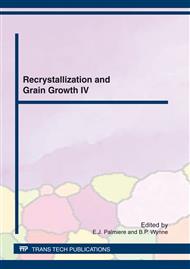p.171
p.173
p.179
p.180
p.186
p.191
p.197
p.203
p.211
Understanding Grain Boundary Junctions: Effect of the Grain Size on Microstructure Evolution
Abstract:
In a previous work [ we introduced the geometry of a granular system that allowed the study of the effect of a finite mobility of the quadruple and triple junctions on grain boundary migration. One of the most important conclusions of this work was that the triple junctions drag more effectively the motion of the grain boundaries than the quadruple junctions. Nevertheless, this conclusion was drawn without consideration of the grain size. For this reason, this conclusion might be contradictory with our understanding of the grain boundary junctions because while the effect of the triple lines is inverse linear with the grain size that of the quadruple junctions is proportional to the inverse square of the grain size and thus, quadruple junctions are expected to drag more effectively, at least, for very small grain sizes. In the present investigation, we studied comprehensively the effect of grain size on the evolution of the granular system under the assumption of a finite mobility of the boundary junctions. For this purpose, several network model simulations were carried out for different grain sizes ranging from nanoto micrometers using a fully periodic grain arrangement. The results seem to corroborate that the triple junctions drag more effectively the motion of the grain boundaries, however, for very low junction mobility and grain sizes the effect appears to be indistinguishable. It was also observed that for very low quadruple junction mobility the geometry of the granular system undergoes a severe transformation which results in the unfulfillment of the equation derived in [.
Info:
Periodical:
Pages:
186-190
Citation:
Online since:
April 2012
Price:
Сopyright:
© 2012 Trans Tech Publications Ltd. All Rights Reserved
Share:
Citation:


